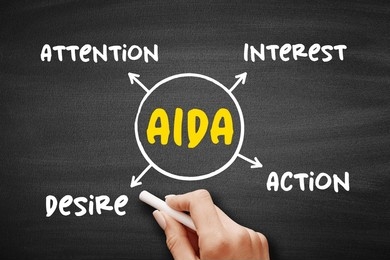
In the fast-paced digital world, grabbing and retaining customers’ attention is more challenging than ever. With constant information overload and short attention spans, brands need to strategically create content that quickly engages their target audience.
An effective method to achieve this is by using the AIDA marketing model framework when structuring marketing content to create attention-grabbing content.
The AIDA model is a time-tested formula for developing compelling messaging that moves prospects through the customer journey. By implementing the four sequential stages of Attention, Interest, Desire and Action, marketers can build content that cuts through the noise to capture interest and drive conversions.
In this blog post, we’ll dive into how to leverage the AIDA model in your 2024 content marketing to create high-impact pieces that attract your ideal customers. Let’s get started!
What is the AIDA Model?
The AIDA model is a consumer behavior theory and one of the oldest marketing frameworks, developed by E. St. Elmo Lewis in 1898. It breaks down the typical customer journey into four key stages.
The acronym AIDA stands for:
- Attention: Capture your audience’s attention
- Interest: Raise their interest by highlighting your key benefits
- Desire: Convince readers your product can fulfil their needs
- Action: Prompt them to take action and convert
Essentially, the AIDA framework maps out the customer journey touchpoints – from initial awareness to purchase intent and final conversion.
Why is the AIDA Model Still Relevant?
Despite being developed over a century ago as one of the earliest marketing theories, the AIDA framework remains highly relevant for modern marketers. This marketing model effectively applies the psychology of human decision-making. The simple four step depiction resonates with how our brains actually process information and make choices.
While initially created for traditional media, AIDA seamlessly translates to today’s digital marketing funnel like social ads, blogs, emails etc. Above all, it provides clear guidance on structuring marketing content by mapping content to the different stages of your customer’s buying journey.
When used right, AIDA powers attention-grabbing content that moves your audience down the marketing funnel towards conversion.
Unlike certain marketing theories that fade with time, this framework has stood the test of time, unlike some marketing theories that become outdated.
How to Apply the AIDA Model to Your Content
Now let’s explore techniques you can employ at each phase of the AIDA model to develop stellar content.
Grab Attention
Launching into elaborate details about your offering right away is bound to lose reader interest rapidly. First, you need high impact content that immediately arrests your target audience’s attention within seconds. Your headers, visuals and opening hook should all be sharp and intriguing, tailored specifically to pique your reader’s curiosity.
- Craft compelling headlines: Research popular searches and pinpoint high ranked yet underserved reader questions to base your headline on.
- Open with an interesting statistic or fact: Present a surprising or little known fact to jolt your readers’ thinking.
- Ask a thoughtful question: Pose an insightful open-ended question that readers want to know the answer to.
- Use striking visuals: Support your points with relevant data visualisations, charts and graphics that pack an informational and visual punch.
- Feature client success stories: Pull your readers in with a specific customer success story showcasing your results.
Generate Interest
After igniting their attention comes the crucial interest phase. This is where you expand upon your initial hook to highlight your product’s value by educating readers on how you can solve their needs. Provide key details on your features and benefits while subtly linking them back to your audience’s pain points.
- Identify your buyer personas: Demonstrate how your solution is tailored for your different customer segments by calling out their particular needs and challenges.
- Explain key features: Outline your product’s or service’s core functions and components that add value for your customers.
- Emphasise specific benefits: Articulate exactly how implementing your offering provides advantages that alleviate their difficulties.
- Add social proof elements: Insert ratings, reviews, expert opinions and relevant case studies to validate your claims.
Create Desire
At this stage, you need to ramp up your persuasion to nudge your audience closer towards taking action. Focus on stirring an emotional desire by highlighting the positive outcomes and transformation they stand to gain. Showcase exactly how your brand can deliver satisfaction and is perfectly positioned to fulfil their aspirations.
- Spotlight results achieved: Provide measurable statistics demonstrating stellar success rates delivered for past clients.
- Share client testimonials: Insert short glowing recommendations that reinforce your capabilities.
- Encourage visualisation: Guide readers to imagine themselves experiencing the benefits by bringing scenes to life.
- Set up scarcity: If applicable, note limited spots or availability to prompt urgency.
Inspire Action
Finally, equip your audience to readily act on their purchase intent generated earlier in your content flow. Reduce any potential friction by being exceptionally clear on the next steps you want readers to take. Shape a compelling call to action (CTA) to funnel them towards conversion.
- Provide a clear call to action: Insert clickable buttons leading to targeted landing pages.
- Simplify instructions: Give step-by-step specifics on signing up, subscribing, downloads or purchases.
- Minimise effort required: Reduce forms to essential fields only and offer handy widgets like live chat.
- Offer incentives: Encourage response with free gift promotions upon sign ups.
Track and Optimise Funnel Performance
While the AIDA model outlines a sequential path, purchase journeys can be iterative involving back and forth steps. Set up solid analytics to monitor engagement rates throughout your funnel to pinpoint drop offs. Identify weaker areas to continually refine your content’s ability to convert.
Conclusion
Despite its conception ages ago, the ingenious AIDA framework continues to be very pertinent in crafting persuasive marketing copy. By guiding your readers’ mindset through Attention, Interest, Desire and Action phases, you can develop stellar content that compels action.
Use these handy tips to inject AIDA techniques into your 2024 content calendar. Stay tuned for more posts on optimising your digital marketing strategy!
Want to take your content creation skills to the next level using proven marketing frameworks like AIDA? Check out our ChatGPT course on Innovative Communication Methods and learn how you can leverage ChatGPT to craft powerful marketing content that your audiences will love. Enrol now!
Read more amazing ChatGPT content here:
- How Instant Messaging is Changing Companies Communication
- Top 5 Best ChatGPT Prompts to Generate Content That Sells
- GPT 4 Turbo VS GPT 3.5



